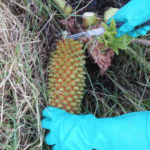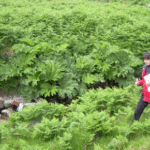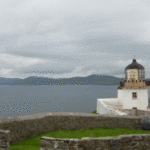Project Background
Alien invasive plant species are currently of global concern, they are considered to be the second largest threat globally, after habitat destruction, to biodiversity.
Gunnera tinctoria is native to Chile and Argentina and is currently an invasive species in the west of Ireland. Although the exact date of its introduction into Ireland is unknown, it was first recorded in the wild in Ireland by Praeger in 1939 on Achill Island. It is a large herbaceous perennial which can grow up to 2 m tall, with leaves of up to 2 m in diameter. It can reproduce by both sexual (seed) and asexual (vegetative) means. Small fragments of the rhizome have the potential to establish new plants and large numbers of seed can be produced, up to 250 000 seeds per mature plant. The plant invades a variety of habitats such as, grassland fields, waterways, roadsides, quarries, bog, heath, coastal cliffs and especially old agricultural fields where is forms large continuous stands.
Project Description
This project is focusing on the control of G. tinctoria on Clare Island. After 3 years of field trials using the herbicide Glyphosate on Achill Island, results showed success in inhibiting the growth of mature G. tinctoria plants and the death of smaller plants.
Due to the size of Clare Island, the size of the population of G. tinctoria on the island, and being an off-shore island, where re-infestations from the mainland could be prevented it was chosen as a candidate for eradication. The distribution of G. tinctoria was mapped on Clare Island, to know the exact location of each plant to be treated.
It is proposed to treat all mature plants with Glyphosate based herbicide using the “cut & paint” methodology of applying herbicides. It involves cutting all the petioles off and applying the herbicide directly to the cut, it is a localised method of application, lowering the environmental impact, in particular for plants close to waterways. Smaller plants will be removed manually, taking care not to leave fragments of the rhizome and will be kept in black plastic bags until decomposed.
Field work 2008
In September 2008 a large area near the quay was treated, in summer 2009 the rest of the island will be treated. For several years after the initial application the island will be revisited to check for any re-growth, and reapplications will take place if necessary. Cleared areas will need restoration afterwards, which will be looked at on a individual basis.
Project Staff and Partners
Cristina Armstrong (National Botanic Gardens) and Deirdre Cunningham (Mayo County Council) with part funding from the Biodiversity Fund, Heritage Council.
- Removing petioles and inflorescence from a Gunnera plant prior to applying Glyphosate to the cut surfaces.
- Large Gunnera plant on Clare Island.
- Achill



